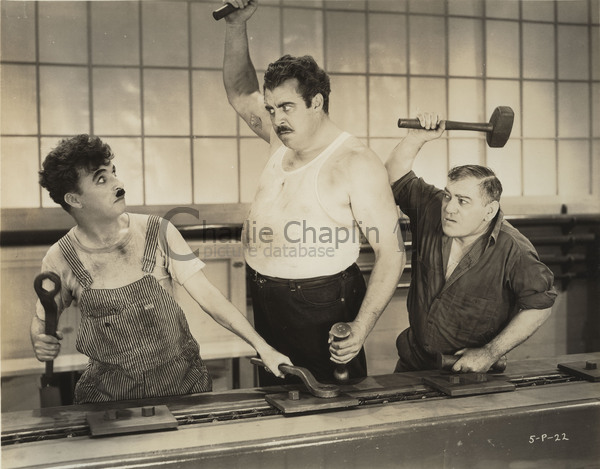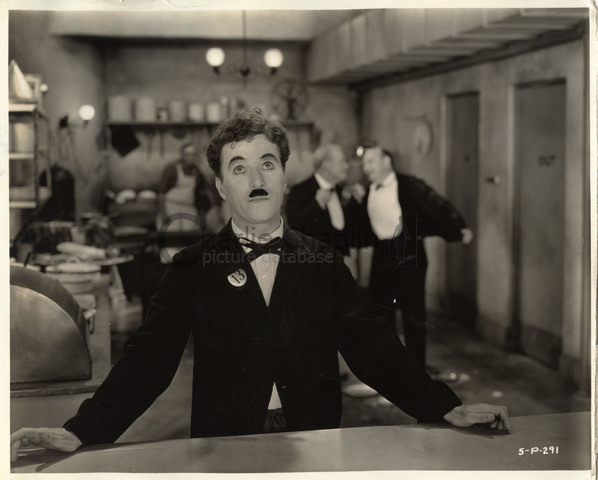Why Did Chaplin Arts Have an Increase in Cash of $67200 When It Recorded Net Income of Only $28000
Filming Mod Times
Modern Times marked the terminal screen appearance of the Trivial Tramp - the character which had brought Charles Chaplin world fame, and who nonetheless remains the well-nigh universally recognised fictional epitome of a homo being in the history of art.
The world from which the Tramp took his good day was very different from that into which he had been built-in, two decades earlier, before the Offset World War. So he had shared and symbolised the hardships of all the underprivileged of a globe only merely emerging from the 19th century. Modern Times found him facing very dissimilar predicaments in the aftermath of America'southward Neat Depression, when mass unemployment coincided with the massive rise of industrial automation.
Chaplin was acutely preoccupied with the social and economic problems of this new age. In 1931 and 1932 he had left Hollywood behind, to embark on an eighteen-month earth tour. In Europe, he had been disturbed to encounter the ascension of nationalism and the social effects of the Depression, of unemployment and of automation. He read books on economic theory; and devised his ain Economic Solution, an intelligent practice in utopian idealism, based on a more than equitable distribution not merely of wealth just of work. In 1931 he told a newspaper interviewer :
"Unemployment is the vital question . . . Machinery should benefit mankind. It should non spell tragedy and throw it out of work."

In Modernistic Times he set out to transform his observations and anxieties into comedy. The piddling Tramp - described in the film credits as "a Manufacturing plant Worker"- is now one of the millions coping with the bug of the 1930s, which are not so very dissimilar from anxieties of the 21st century - poverty, unemployment, strikes and strike breakers, political intolerance, economic inequalities, the tyranny of the machine, narcotics. The flick'southward portentous opening championship - "The story of manufacture, of private enterprise - humanity crusading in the pursuit of happiness" - is followed by a symbolic juxtaposition of shots of sheep existence herded and of workers streaming out of a mill. Chaplin's character is first seen equally a worker existence driven crazy past his monotonous, inhuman piece of work on a conveyor belt and being used as a republic of guinea sus scrofa to examination a auto to feed workers every bit they work.
Paulette Goddard
Exceptionally, the Tramp has a companion in his battle with this new world. On his return to America subsequently a earth tour in 1931, Chaplin had met the extra Paulette Goddard, who was to remain, for several years, an ideal partner in his private life. Her personality inspired the character of the "Gamine" in Mod Times - a young girl whose male parent has been killed in a labour demonstration, and who joins forces with Chaplin. The couple are neither rebels nor victims, but, wrote Chaplin, "The only 2 live spirits in a world of automatons. We are children with no sense of responsibility, whereas the rest of humanity is weighed downwards with duty. We are spiritually free". In a sense, then, they are anarchists.
Chaplin at get-go planned a sadly sentimental catastrophe for the film. While the Tramp was in hospital, recovering from nervous break-down, the Gamine was to become a Nun then be parted from him for ever. This ending was filmed, simply was finally abandoned in favour of a more cheerful finale. "We'll get forth", says a title; and the couple, arm in arm, set bravely off down a country lane, towards the horizon
By the fourth dimension Modernistic Times was released, talking pictures had been established for nigh a decade. Till now, Chaplin had resisted dialogue, knowing that his comedy and its universal agreement depended on silent pantomime. This time though he weakened to the extent of preparing dialogue, and even doing some trial recordings. Finally he thought amend of it, and as in City Lights uses only music and sound effects. Human voices are only heard filtered through technological devices - the boss who addresses his workers from a boob tube screen; the salesman who is only a vox on the phonograph.

Only at one moment, though, Chaplin's own vox is heard directly. Hired as a waiter, the Little Worker is required to stand in for the romantic café tenor. He writes the words on his shirt cuffs, only these wing off with a too-dramatic flourish; and he is obliged to improvise the song in a wonderful, mock-Italian gibberish. Chaplin'southward voice had already been heard on radio and in at least one newsreel, but this was the first and but time that the globe heard speech from the Niggling Tramp.
Apart from this indecision over sound and the changed ending, the shooting seems to take been fairly untroubled and, past Chaplin's standards, comparatively fast. It may have helped that the essential construction is neatly devised in four "acts" each 1 more or less equivalent to one of his old two-reel comedies. Equally the gimmicky American critic Otis Ferguson wrote, they might have been individually titled The Shop, The Jailbird, The Watchman and The Singing Waiter.
As he had done for City Lights Chaplin composed his own musical score, giving his arrangers and conductors a harder time than usual, with the outcome that the distinguished Hollywood musician Alfred Newman walked off the flick.
The film became the victim of a strange charge of plagiarism. The Franco-German firm of Tobis claimed that Chaplin had stolen ideas and scenes from some other archetype film most the 20th century industrial world, A Nous la Liberté, directed past René Clair. The case was weak, and Clair, a great admirer of Chaplin, was deeply embarrassed by it. Nevertheless Tobis persisted, and even renewed its claims in May 1947, after the Second Earth War. This fourth dimension the Chaplin Studio finally agreed to a modest payment, just to go rid of the nuisance. Chaplin and his lawyers remained convinced that the determination of the German-dominated visitor was revenge for the anti-Nazi sentiment of The Great Dictator.
Happily for posterity, Tobis failed in their original demand to have Chaplin¹south film permanently suppressed. Instead, Modern Times survives as a commentary on human being survival in the industrial, economic and social circumstances of the 20th century club. It remains as relevant, in human terms, for the 21st century.
The Claiming of Sound
The inflow of audio films was a bigger challenge for Chaplin than for any other actor or manager. He had won world fame with the universal linguistic communication of pantomime. If the Little Tramp at present began to speak in English he would go incomprehensible to a large part of his international audience. In 1931 he predicted that talking pictures would not final six months, and told an interviewer that 'Dialogue may or may not have a place in comedy . . . dialogue does non have a identify in the sort of comedies I make . .. For myself I know that I cannot use dialogue.' When the interviewer asked him if he had tried using speech communication in his films, he retorted "I never tried jumping off the monument in Trafalgar Square, but I accept a definite idea that information technology would exist unhealthful. . . For years I take specialized in one type of comedy - strictly pantomime. I have measured it, gauged it, studied. I take been able to establish verbal principles to govern its reactions on audiences. It has a certain pace and tempo. Dialogue, to my style of thinking, always slows activity, because action must look upon words."
By the time he came to prepare Modern Times however, it seemed that he had steeled himself to use speech. In the Chaplin archives there is a dialogue script for all scenes in Modern Times up to and including the department shop sequence. The dialogue which Chaplin planned for his own character is staccato, quippy, touched with nonsense. He began to rehearse the dialogue for the scenes in the jail and warden's part; merely later but a twenty-four hour period or so seems to have been deeply dissatisfied with the results. No more dialogue scenes were to be shot for Modernistic Times.
Chaplin did proceed with audio furnishings, yet, and took a personal involvement in the technique of their cosmos. For a scene involving rumbling stomachs, he created the noises himself by blowing bubbles into a pail of water. The fact that Chaplin was sufficiently peachy to create the effects himself in this way suggests the extent to which he was intrigued by audio problems at this fourth dimension. A memorandum about possible musical effects notes: 'Natural sounds function of composition, i.e. Auto horns, sirens, and cowbells worked into the music.' The sound furnishings became an element of the musical score.
The Premieres
Modern Times was launched more quietly than previous Chaplin films. The film opened in New York on 5 February 1936, and in London on 11 February. Chaplin and his co-star Paulette Goddard attended a third and the virtually glamorous "premiére" in Hollywood on 12 February. The venue was Grauman's Chinese Theatre, which had opened in 1927 as "a shrine to art … the crowning achievement of a brilliant career … the realization of the vision of a simple soul, a primary showman … Sid Grauman". The guests were handed programmes designed in lush and glamorous Fine art Deco style, printed in black and red on gold paper.
In the by Grauman had devised elaborate live stage shows for Chaplin premieres, but this time the amusement was entirely on screen, with a newsreel, a travelogue, a Technicolor interest film, and the latest issue of the electric current documentary series The March of Time - though, emphasising its topicality, this was appear equally "Field of study to weather conditions for Air Express".
The well-nigh notable particular in the supporting plan was a new Silly Symphony from the Walt Disney Studios, Mickey's Orphan Concert. The inclusion of this cartoon exemplified an intense mutual adoration between Chaplin and Disney, who both recognised similarities in the other'due south work. Disney bought advertising space in the program, "In appreciation of the pantomimist supreme whose inimitable artistry and adroitness are timeless". It was signed, "Mickey Mouse and Walt Disney".
Text by David Robinson © 2004 MK2 SA
Source: https://www.charliechaplin.com/en/articles/6-Filming-Modern-Times
0 Response to "Why Did Chaplin Arts Have an Increase in Cash of $67200 When It Recorded Net Income of Only $28000"
Post a Comment